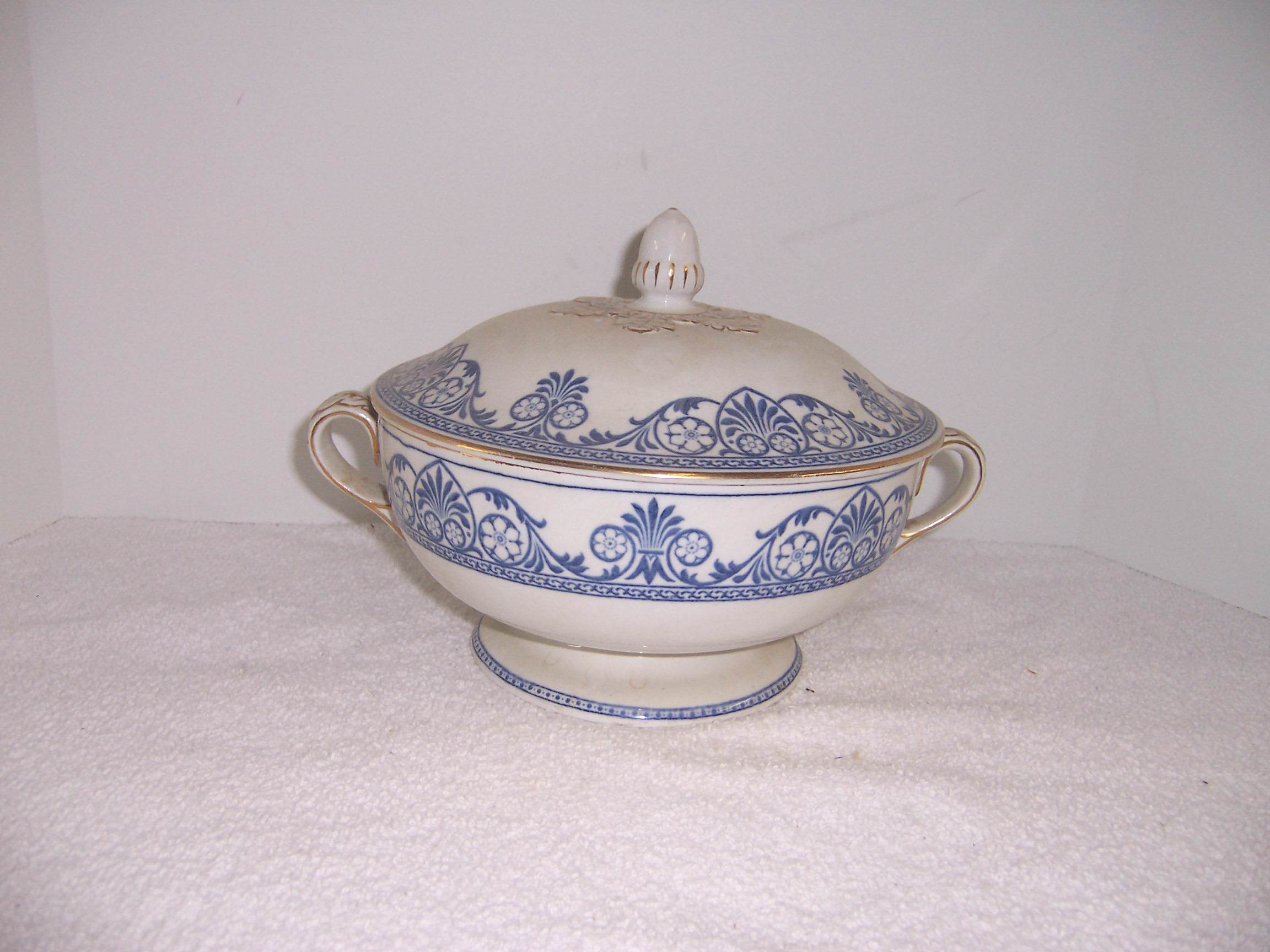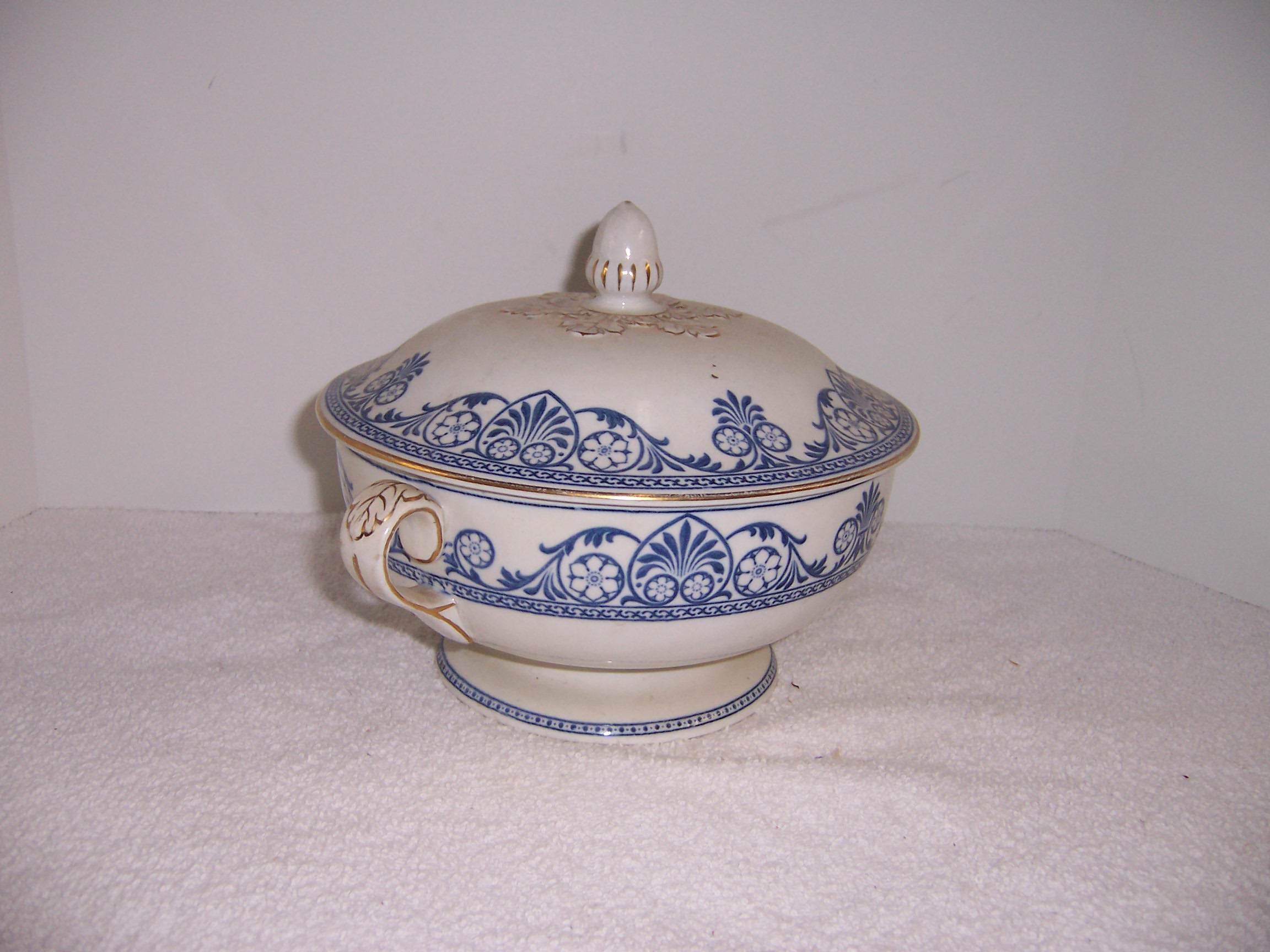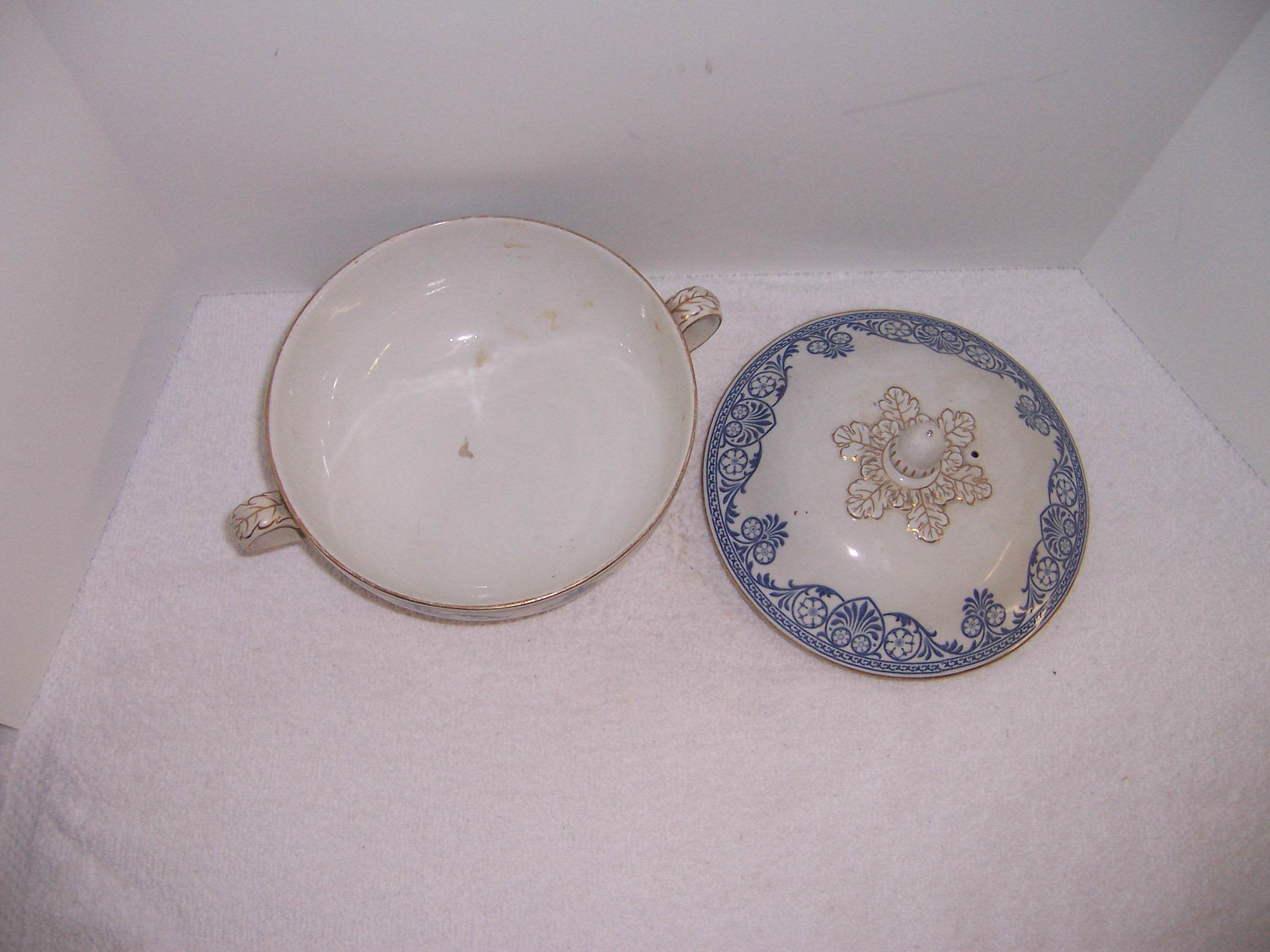Description
Wedgewood Anthea Blue White Covered Dish in good used condition for its age. It measures 7″ high x 10″ x 7.75″.
WEDGEWOOD
Josiah Wedgwood and Sons, commonly known as Wedgwood, is a pottery firm owned by KPS Capital Partners, a private equity company based in New York City. Wedgwood was founded on 1 May 1759 by Josiah Wedgwood and in 1987 merged with Waterford Crystal to create Waterford Wedgwood, an Ireland-based luxury brands group. After the 2009 purchase by KPS Capital, Wedgwood became part of a group of companies known as WWRD Holdings Ltd, an acronym for “Waterford Wedgwood Royal Doulton.”
The family and company history
Typical wedgwood blue plate with white decor
Kutani Crane by Wedgwood
Portland Vase, about 1790
Wedgwood Room with porcelain panels, in the palace of Archduke Albert in Vienna
Josiah Wedgwood worked with the established potter Thomas Whieldon until 1759 when relatives leased him the Ivy House in Burslem, allowing him to start his own pottery business. The launch of the new venture was helped by his marriage to a remote cousin Sarah (also Wedgwood) who brought a sizeable dowry with her.
Belt clasp designed by Lady Templeton and Miss Crew for Josiah Wedgwood’s factory. The Walters Art Museum.
In 1765, Wedgwood created a new earthenware form which impressed the then British Queen consort Charlotte of Mecklenburg-Strelitz who gave permission to call it “Queen’s Ware”; this new form sold extremely well across Europe. The following year Wedgwood bought Etruria, a large Staffordshire estate, as both home and factory site. Wedgwood developed a number of further industrial innovations for his company, notably a way of measuring kiln temperatures accurately and new ware types Black Basalt and Jasper Ware. Wedgwood’s most famous ware is jasperware. It was created to look like ancient cameo glass. It was inspired by the Portland Vase, a Roman vessel which is now a museum piece.. (The first jasperware colour was Portland Blue, an innovation that required experiments with more than 3,000 samples). In recognition of the importance of his pyrometric beads (pyrometer), Josiah Wedgwood was elected a member of the Royal Society in 1783. Today, the Wedgwood Prestige collection sells replicas of some of the original designs as well as modern neo-classical style jasperware.
The main Wedgwood motifs in jasperware, as well as in other wares like basaltware, queensware, caneware, etc., were decorative designs that were highly influenced by the ancient cultures being studied and rediscovered at that time, especially as Great Britain was expanding her Empire. Many motifs were taken from ancient mythologies: Roman, Greek or Egyptian. Meanwhile, archaeological fever caught the imagination of many artists. Nothing could have been more suitable to satisfy this huge business demand than to produce replicas of ancient artefacts.[citation needed] Many representations of royalty, nobles and statesmen in silhouette were created, as well as political symbols. These were often set in jewellery, as well as in architectural features like fireplace mantels, mouldings and furniture. Wedgwood has honoured several American individuals and corporations as well, both historically and recently. In 1774 he employed the then 19-year-old John Flaxman as an artist, who would work for the next 12 years mostly for Wedgwood. The “Dancing Hours” may be his most well known design. Other artists known to have worked for Wedgwood include among others Lady Elizabeth Templetown, George Stubbs, Emma Crewe and Lady Diana Beauclerk.
Wedgwood had increasing success with hard paste porcelain which attempted to imitate the whiteness of tea-ware imported from China, an extremely popular product amongst high society. High transportation costs and the demanding journey from the Far East meant that the supply of chinaware could not keep up with increasingly high demand. Towards the end of the eighteenth century other Staffordshire manufacturers introduced bone china as an alternative to translucent and delicate Chinese porcelain. In 1812 Wedgwood produced their own bone china which, though not a commercial success at first eventually became an important part of an extremely profitable business.
Josiah Wedgwood was also a patriarch of the Darwin–Wedgwood family. Many of his descendants were closely involved in the management of the company down to the time of the merger with the Waterford Company:
John Wedgwood, eldest son of Josiah I, was a partner in the firm from 1790 to 1793 and again from 1800 to 1812.
Josiah Wedgwood II (1769–1843), second son of Josiah I, succeeded his father as proprietor in 1795 and introduced the production by the Wedgwood company of bone china. In 1815, during Josiah II’s time as proprietor, the great English Romantic poet William Blake (1757–1827) spent some time engraving for Wedgwood’s china catalogues.
Josiah Wedgwood III (1795–1880), son of Josiah II, was a partner in the firm from 1825 until he retired in 1842.
Francis Wedgwood, son of Josiah II, was a partner in the firm from 1827 and sole proprietor following his father’s death until joined by his own sons. Financial difficulties caused him to offer for sale soon after taking over the firm its factory at Etruria and the family home Etruria Hall, but in the event and fortunately for the company only the hall was sold. He continued as senior partner until his retirement to Barlaston Hall in 1876.
Godfrey Wedgwood (1833–1905), son of Francis Wedgwood, was a partner in the firm from 1859 to 1891. He and his brothers were responsible for the reintroduction of bone china c.1876 and the employment of the artists Thomas Allen and Emile Lessore.
Clement Wedgwood (1840–1889), son of Francis Wedgwood, was a partner.
Laurence Wedgwood (1844–1913), son of Francis Wedgwood, was a partner.
Major Cecil Wedgwood DSO (1863–1916), son of Godfrey Wedgwood, partner from 1884, first Mayor of the federated County Borough of Stoke-on-Trent (1910–1911), was chairman and managing director of Wedgwood until his death in battle in 1916.
Kennard Laurence Wedgwood (1873–1949), son of Laurence Wedgwood, was a partner. In 1906 he went to the United States and set up the firm’s New York office, which became Josiah Wedgwood and Sons USA, an incorporated subsidiary, in 1919.
Francis Hamilton Wedgwood (1867–1930), eldest son of Clement Wedgwood, was chairman and managing director from 1916 until his sudden death in 1930.
Josiah Wedgwood V (1899–1968), grandson of Clement Wedgwood and son of Josiah Wedgwood, 1st Baron Wedgwood, was managing director of the firm from 1930 until 1968 and credited with turning the company’s fortunes around. He was responsible for the enlightened decision to move production to a modern purpose built factory in a rural setting at Barlaston. It was designed by Keith Murray in 1936 and built between 1938 and 1940. He was succeeded as managing director by Arthur Bryan (later Sir Arthur), who was the first non-member of the Wedgwood family to run the firm.
Enoch Wedgwood (1813–1879), a distant cousin of the first Josiah, was also a potter and founded his own firm, Wedgwood & Co, in 1860. It was taken over by Josiah Wedgwood & Sons in 1980.
The company from 1986 to 2008
In 1986, Waterford Glass Group plc purchased Wedgwood plc for US$360 million, with Wedgwood delivering a 38.7 million USD profit in 1998 (when Waterford itself lost $28.9 million) after which the group was renamed Waterford Wedgwood. From early 1987 to early 1989, the CEO was Patrick Byrne, previously of Ford, who then became CEO of the whole group. During his time, he sold off non-core businesses, and reduced the range of Wedgwood patterns from over 400 to around 240. In the late 1990s, the CEO was Brian Patterson. From 1 January 2001, the Deputy CEO was Tony O’Reilly, Junior, who was appointed CEO in November of the same year and resigned in September 2005. He was succeeded by the then president of Wedgwood USA, Moira Gavin up until the company went into administration in 2009.
In 2001 Wedgwood launched a collaboration with designer Jasper Conran which started with a white fine bone china collection then expanded to include seven patterns.
The company from 2009
On 5 January 2009, following years of financial problems at group level, and after a share placement failed during the global financial crisis of 2008, Wedgwood was placed into administration on a “going concern” basis, with 1800 employees remaining. On 27 February 2009, Waterford Wedgwood’s receiver Deloitte announced that the New York-based private equity firm KPS Capital Partners had purchased “certain Irish and UK assets of Waterford Wedgwood and the assets of several of its Irish and UK subsidiaries” in a transaction expected to be completed in March. In March 2009, KPS Capital Partners announced that it had acquired group assets in a range of countries, including the UK, USA and Indonesia, would invest €100 million, and move a number of jobs to Asia to cut costs and return the firm to profitability. In a move that had begun under the previous owners, some 1,500 jobs were cut in the UK, leaving 800 workers in the UK producing only the high-end Wedgwood products. KPS Capital Partners has placed Wedgwood into a group of companies known as WWRD, an acronym for “Waterford Wedgwood Royal Doulton.”
Wedgwood Museums and the Museum Trust
Wedgwood’s founder wrote as early as 1774 that he wished he had preserved samples of all the company’s works, and began to do so. The first formal museum was opened in May 1906, with a curator named Isaac Cooke, at the main (Etruria) works. The contents of the museum were stored for the duration of World War II and relaunched in a gallery at the new Barlaston factory in 1952. A new purpose-built Visitor Centre and Museum was built in 1975 and remodelled in 1985 with pieces displayed near items from the old factory works in cabinets of similar period. A video theatre was added and a new gift shop as well as an expanded demonstration area where visitors could watch pottery being made. A further renovation costing 4.5 million pounds was carried out in 2000, including access to the main factory itself, following which the Visitor Centre complex won multiple awards.
Adjacent to the museum and visitor centre are a restaurant and tea room, serving on Wedgwood ware. The museum, managed by a dedicated trust, closed in 2000 and on 24 October 2008 reopened in a new multi-million pound building.
In June 2009, the Wedgwood Museum won a UK Art Fund Prize for Museums and Art Galleries for its displays of Wedgwood pottery, skills, designs and artefacts. In May 2011, the archive of the museum was inscribed in UNESCO’s UK Memory of the World Register.
The Minton Archive is a separate part of the collection. It comprises papers and drawings of the designs, manufacture and production of the pottery company Mintons covering the period 1793–1968 and the artistic and industrial archives of Royal Doulton. The liquidation of Wedgwood placed this collection under threat of break-up and sale.







